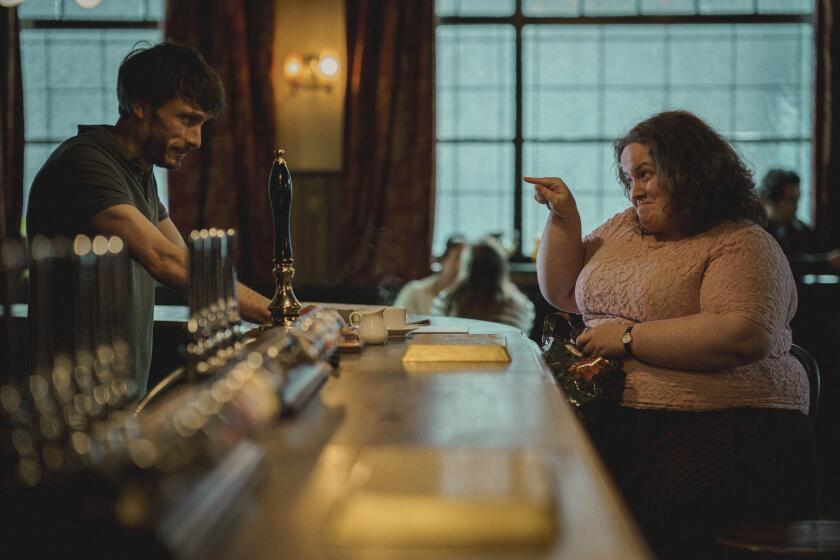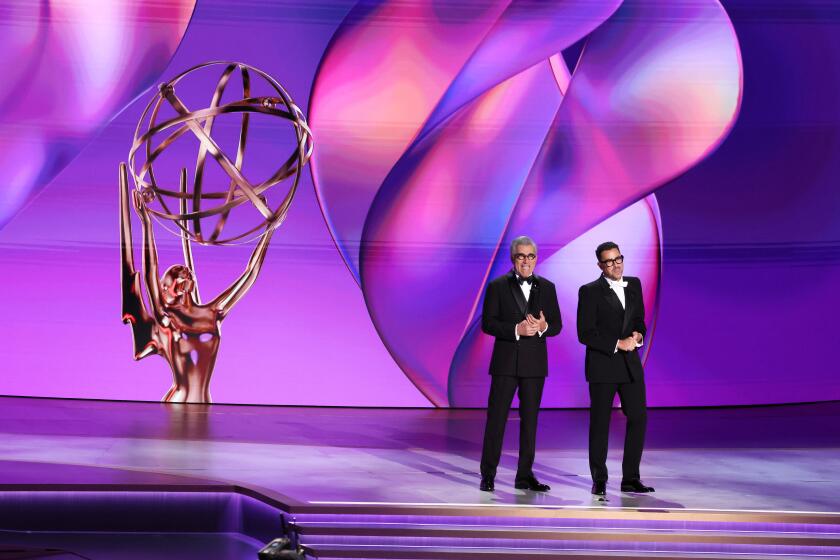Hollywood United Methodist Church puts its faith in filming

Location manager Brian O’Neill needed a location to film a wedding scene for the upcoming move “The Wedding Ringer,” and he knew just the place: Hollywood United Methodist Church at the corner of Franklin and North Highland avenues.
With its Gothic Revival cathedral, stained-glass windows, breezy courtyards and lush gardens, the church would be an ideal setting for the Screen Gems movie, in which comedian Kevin Hart runs a wedding consulting business.
But there was another reason to select the church for the upcoming wedding scene.
PHOTOS: Hollywood Backlot moments
“Not only does it work aesthetically,” O’Neill said, “But they [the church pastors] are extremely content friendly. They have their arms open to the film community. They know that’s what Hollywood was built on.”
“The Wedding Ringer” is just the latest in a long line of movies and TV shows that have used Hollywood United Methodist Church as a filming location. Built in the 1930s, the church is one of Hollywood’s most visible landmarks.
Billing itself as the “heart of Hollywood,” the church has played a recurring role in dozens of TV shows and movies, including the 1985 film “Back to the Future” and the HBO series “Big Love.”
The Rev. Kathy Cooper-Ledesma, the senior pastor, has a pragmatic view about filming, which raises capital for the church to fund outreach programs for the homeless and disadvantaged.
“It’s vital and not only supports our families, but it really enables us to do more mission and ministry work in the community and in other ways,” she said.
PHOTOS: Celebrities by The Times
The church charges from $2,000 to $20,000 a day to film crews, depending on the scope of the production. The location filming generates $25,000 or more in annual revenue, or about 5% of the church’s overall income.
That’s far less than what the church collected more than a decade ago, when the local film industry boomed, bringing in as much as $80,000 in revenue a year.
Still, the funds help support a program to feed homeless adults every Tuesday and a bimonthly dinner at the PATH Hollywood homeless shelter, as well as mission work, including a trip to Haiti to support hurricane victims. This week volunteers will travel to New Jersey to help in the rebuilding of the Jersey shore boardwalk.
Aside for raising money, Cooper-Ledesma also encourages film activity because many parishioners work in the industry. About 40% of the congregation members are actors, casting directors, writers, producers, camera operators and other industry professionals.
Even the church’s associate pastor, the Rev. Dave Stambaugh, has his own list of credits, having worked as a child actor in the 1976 film “The Bad News Bears” and other movies.
Reflecting its location, the church has a summer sermon series that highlights the spiritual themes in such movies such as “The Blind Side,” and invites filmmakers, actors and directors to talk about their movies in a question-and-answer session. Recent guests have included and Dustin Lance Black, an Oscar-winning screenwriter and director.
ON LOCATION: Where the cameras roll
“Filming is important to us as a church because we like to see folks in our congregation employed,” Cooper-Ledesma said. “We have a lot of folks who are in the industry and who work behind the scenes, and when there is no filming it is draining on them. They’ve got families and L.A. is not a cheap place to live. We’re always thrilled when someone in the congregation gets an on-camera job and it always hurts when they say ‘I’m going to Vancouver, Louisiana or Atlanta.’”
Hollywood United Methodist has been fulfilling both the spiritual and practical needs of Hollywood for decades. One of the earliest movies to use the church was the 1959 Lana Turner film “Imitation of Life,” which included a scene in which gospel singer Mahalia Jackson performed in the choir loft.
Although the cathedral is a big draw, other buildings also have been popular locations.
In the 1985 movie “Back to the Future,” the gym served as the site of Hill Valley High’s “Enchantment Under the Sea” dance scene, in which Marty McFly’s parents fall in love.
It also played the college gym where the Oneders (later in the film known as the Wonders) performed in the 1996 Tom Hanks film “That Thing You Do!” Talk show host Jimmy Kimmel often uses the basketball court for segments of his show.
A meeting room called Grant Hall played a funeral parlor in “Jarhead,” a commissary in “Sister Act” and a community center in HBO’s “Big Love.”
A Cars.com commercial transformed the church lobby into a medieval castle.
The ABC Family show “Bunheads” filmed its series finale there this year, depicting the church as a popular audition center. Many touring stage shows and groups that perform at the Hollywood Bowl use the gymnasium for rehearsals and auditions.
The Warner Bros. movie “Gangster Squad” didn’t film at the church, but used its large parking lot as a base camp.
Even when the church isn’t used as a location, it often appears on the big screen. Before moving from New Jersey several years ago to take his current job, Stambaugh recalls watching a chase scene from one of his favorite movies, “The Italian Job,” that had been shot along Highland Avenue. “I said, ‘I know that church — that’s where I’m going to work.’”
Although they support the film industry, the two pastors balk at some projects.
Cooper-Ledesma said she declined when the producers of “CSI” wanted to film a murder scene in the sanctuary. Instead she allowed a scene in which the priest could discover a dead body there. “It was a subtle distinction, but we had to draw the line at that.”
The church also turned down a request from the HBO series “True Blood” to film a sex scene on the altar.
“You can imagine for a number of reasons every time somebody comes to your church, you don’t want people to say, ‘Oh, that’s where they had vampire sex,’” Stambaugh said.
More to Read
From the Oscars to the Emmys.
Get the Envelope newsletter for exclusive awards season coverage, behind-the-scenes stories from the Envelope podcast and columnist Glenn Whipp’s must-read analysis.
You may occasionally receive promotional content from the Los Angeles Times.







